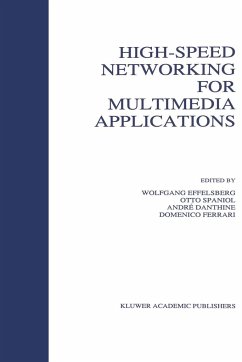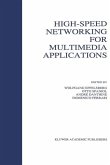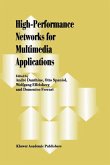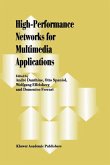Wolfgang Effelsberg / Otto Spaniol / Andr Danthine / Domenico Ferrari (eds.)
High-Speed Networking for Multimedia Applications
Herausgegeben:Effelsberg, Wolfgang; Spaniol, Otto; Danthine, André; Ferrari, Domenico
Schade – dieser Artikel ist leider ausverkauft. Sobald wir wissen, ob und wann der Artikel wieder verfügbar ist, informieren wir Sie an dieser Stelle.
Wolfgang Effelsberg / Otto Spaniol / Andr Danthine / Domenico Ferrari (eds.)
High-Speed Networking for Multimedia Applications
Herausgegeben:Effelsberg, Wolfgang; Spaniol, Otto; Danthine, André; Ferrari, Domenico
- Gebundenes Buch
- Merkliste
- Auf die Merkliste
- Bewerten Bewerten
- Teilen
- Produkt teilen
- Produkterinnerung
- Produkterinnerung
High-Speed Networking for Multimedia Applications presents the latest research on the architecture and protocols for high-speed networks, focusing on communication support for distributed multimedia applications. This includes the two major issues of ATM Networking and quality of service for multimedia applications. It is to be expected that most of the bandwidth in future high-speed networks will be taken up by multimedia applications, transmitting digital audio and video. Traditional networking protocols are not suitable for this as they do not provide guaranteed bandwidth, end-to-end delay…mehr
Andere Kunden interessierten sich auch für
![High-Speed Networking for Multimedia Applications High-Speed Networking for Multimedia Applications]() High-Speed Networking for Multimedia Applications153,99 €
High-Speed Networking for Multimedia Applications153,99 €![Architecture and Protocols for High-Speed Networks Architecture and Protocols for High-Speed Networks]() Architecture and Protocols for High-Speed Networks149,99 €
Architecture and Protocols for High-Speed Networks149,99 €![ATM Network Performance ATM Network Performance]() George KesidisATM Network Performance75,99 €
George KesidisATM Network Performance75,99 €![Architecture and Protocols for High-Speed Networks Architecture and Protocols for High-Speed Networks]() Otto Spaniol / Andr‚ Danthine / Wolfgang Effelsberg (Hgg.)Architecture and Protocols for High-Speed Networks153,99 €
Otto Spaniol / Andr‚ Danthine / Wolfgang Effelsberg (Hgg.)Architecture and Protocols for High-Speed Networks153,99 €![ATM Network Performance ATM Network Performance]() George KesidisATM Network Performance77,99 €
George KesidisATM Network Performance77,99 €![High-Performance Networks for Multimedia Applications High-Performance Networks for Multimedia Applications]() DanthineHigh-Performance Networks for Multimedia Applications77,99 €
DanthineHigh-Performance Networks for Multimedia Applications77,99 €![High-Performance Networks for Multimedia Applications High-Performance Networks for Multimedia Applications]() High-Performance Networks for Multimedia Applications75,99 €
High-Performance Networks for Multimedia Applications75,99 €-
-
High-Speed Networking for Multimedia Applications presents the latest research on the architecture and protocols for high-speed networks, focusing on communication support for distributed multimedia applications. This includes the two major issues of ATM Networking and quality of service for multimedia applications.
It is to be expected that most of the bandwidth in future high-speed networks will be taken up by multimedia applications, transmitting digital audio and video. Traditional networking protocols are not suitable for this as they do not provide guaranteed bandwidth, end-to-end delay or delay jitter, nor do they have addressing schemes or routing algorithms for multicast connections.
High-Speed Networking for Multimedia Applications is a collection of high quality research papers which address these issues, providing interesting and innovative solutions. It is an essential reference for engineers and computer scientists working in this area. It is also a comprehensive text for graduate students of high-speed networking and multimedia applications.
It is to be expected that most of the bandwidth in future high-speed networks will be taken up by multimedia applications, transmitting digital audio and video. Traditional networking protocols are not suitable for this as they do not provide guaranteed bandwidth, end-to-end delay or delay jitter, nor do they have addressing schemes or routing algorithms for multicast connections.
High-Speed Networking for Multimedia Applications is a collection of high quality research papers which address these issues, providing interesting and innovative solutions. It is an essential reference for engineers and computer scientists working in this area. It is also a comprehensive text for graduate students of high-speed networking and multimedia applications.
Produktdetails
- Produktdetails
- Verlag: Springer / Springer Netherlands / Springer US
- Artikelnr. des Verlages: 978-0-7923-9681-9
- 1996.
- Seitenzahl: 384
- Erscheinungstermin: 31. März 1996
- Englisch
- Abmessung: 234mm x 156mm x 22mm
- Gewicht: 1620g
- ISBN-13: 9780792396819
- ISBN-10: 0792396812
- Artikelnr.: 24959924
- Herstellerkennzeichnung
- Libri GmbH
- Europaallee 1
- 36244 Bad Hersfeld
- gpsr@libri.de
- Verlag: Springer / Springer Netherlands / Springer US
- Artikelnr. des Verlages: 978-0-7923-9681-9
- 1996.
- Seitenzahl: 384
- Erscheinungstermin: 31. März 1996
- Englisch
- Abmessung: 234mm x 156mm x 22mm
- Gewicht: 1620g
- ISBN-13: 9780792396819
- ISBN-10: 0792396812
- Artikelnr.: 24959924
- Herstellerkennzeichnung
- Libri GmbH
- Europaallee 1
- 36244 Bad Hersfeld
- gpsr@libri.de
Otto Spaniol (Jahrgang 1945) gehört zu den Informatikern 'der ersten Stunde' (oder vielleicht etwas bescheidener ausgedrückt: "des zweiten Monats") in Deutschland. Während des Mathe- und Physikstudium diffundierte er unter Anleitung seines Lehrmeisters Günter Hotz in die damals noch nicht offiziell existierende Informatik. Seine GI-Mitgliedsnummer (59) ist schon beinahe unwirklich niedrig. Nach einer Assistenzprofessur in Saarbrücken wurde er 1976 auf eine C3- Professur nach Bonn berufen und im Jahr 1981 auf den Lehrstuhl für Betriebssysteme an der Universität Frankfurt/Main. Durch seine Bonner Zeit zum Wahlrheinländer mutiert, zog es ihn in diese Gegend zurück. Seit 1984 war er bis zur Emeritierung im Jahr 2010 Inhaber des Lehrstuhls Kommunikation und verteilte Systeme an der RWTH Aachen. Die Absurditäten des täglichen Informatikwahnsinns veranlassten ihn schon früh zur Abfassung von manchmal recht bösartigen Glossen - meist unter dem Pseudonym "Alois Potton" (was genauer betrach
tet ein Anagramm seines Namens ist).
tet ein Anagramm seines Namens ist).
1 End-to-End Communication Across Hybrid Networks.- 1 Introduction.- 2 The IEEE 802.11 Wireless LAN.- 3 Internetworking among Wireless and Fixed Networks.- 4 Evaluation of Selected Functions.- 5 Summary and Outlook.- 2 Reduce Connection Awareness.- 1 Introduction.- 2 Design and Guidelines for Reducing Connection Awareness.- 3 Issues for the Implementation of the Design Guidelines.- 4 A First Step: Efficient Signaling for VPTS.- 5 Conclusions.- 3 Is ATM a Continuity or a Discontinuity for the LAN Environment?.- 1 Introduction.- 2 The ITU View of the ATM.- 3 The Legacy LANs.- 4 The ATM LAN Paradigms.- 5 VBR Sources.- 6 TCP/IP and ATM.- 7 LAN Interconnection over the Wide Area.- 8 New Applications.- 9 Conclusions.- 4 On the Performance of Networks Carrying Multimedia Traffic.- 1 Introduction.- 2 Multimedia Traffic Requirements.- 3 Video Encoding Schemes and Traffic Characterization.- 4 Performance of Networks Carrying Video Traffic.- 5 Conclusions.- 5 The Server Array: A Scalable Video Server Architecture.- 1 Introduction.- 2 Scenario.- 3 Video Server Architecture and Scalability.- 4 The Design of a Video Server Array for Video On-Demand.- 5 Choice of a Striping Block Size.- 6 Reliability Aspects.- 7 Related Work.- 8 Conclusions.- 6 A Scalable Architecture for Multimedia Storage.- 1 Introduction.- 2 Data Distribution Strategies on Multiple Servers.- 3 Scalable Compression Technology.- 4 ATM Based Scalable Storage.- 5 Summary and Future Work.- 7 Aqua: An Adaptive End-System Quality of Service Architecture.- 1 Introduction.- 2 Overview of AQUA.- 3 QoS Specification.- 4 Rate based Adjustable Priority Scheduling.- 5 Performance Evaluation.- 6 Related Work.- 7 Conclusions.- 8 Quality of Service Support for Protocol Processing within Endsystems.- 1 Introduction.- 2 QoS Specification.- 3 QoS Mapping.- 4 QoS Enforcement.- 5 Protocol Implementation Model.- 6 Conclusions.- 9 High Performance Group Communication Services in ATM Networks.- 1 Introduction.- 2 Enhanced Services in ATM Networks.- 3 Efficient Provision of Reliable Multipoint Services.- 4 Assessment of Performance and Implementation.- 5 Conclusions.- 10 Multimedia Transport Protocol and Multicast Communication.- 1 Introduction.- 2 Transport Layer Multicast.- 3 Statistical Reliable Multicast.- 4 Other Multicast Issues.- 5 Conclusions.- 11 PET - Priority Encoding Transmission.- 1 Introduction.- 2 Methodology.- 3 PET Systems.- 4 Implementation Issues.- 5 Conclusions.- 12 Real-Time Communication in Shared-Medium High Speed LANs.- 1 Introduction.- 2 The Fiber Distributed Data Interface.- 3 The Distributed Queue Dual Bus.- 4 The Demand Priority LAN.- 5 Performance Analysis.- 6 Conclusions.- 13 Batch Renewal Process: Exact Model of Traffic Correlation.- 1 Introduction.- 2 Correlation in Traffic Processes.- 3 Choice of Model for Traffic Characterized by its Correlation.- 4 Construction of a Batch Renewal Process.- 5 Effects on a Simple Queue.- 6 Effect of a Queue on Correlation - Creation of Burst Structure.- 7 Conclusions and other Remarks.- 14 Residential Oriented Customer Premises Network Based on ATM Principles.- 1 Introduction.- 2 Residential CPN Characteristics.- 3 An ATM Distributed Architecture.- 4 Simulation Results.- 5 Conclusions.- 15 Voice-Data Integrated Channel Access for Microcellular Networks Using Splitting RRA Algorithms.- 1 Introduction.- 2 System Model.- 3 Channel Conditions.- 4 Voice Transmission Protocols.- 5 Simulation Results.- 6 Conclusions.- 16 Wireless Access to High Speed Networks.- 1 Introduction.- 2 High Speed and Mobility.- 3 Current Wireless Local AreaNetworks.- 4 Strategies of Interconnection.- 5 Discussion of Problems.- 6 Final Remarks.- Index of Authors.
1 End-to-End Communication Across Hybrid Networks.- 1 Introduction.- 2 The IEEE 802.11 Wireless LAN.- 3 Internetworking among Wireless and Fixed Networks.- 4 Evaluation of Selected Functions.- 5 Summary and Outlook.- 2 Reduce Connection Awareness.- 1 Introduction.- 2 Design and Guidelines for Reducing Connection Awareness.- 3 Issues for the Implementation of the Design Guidelines.- 4 A First Step: Efficient Signaling for VPTS.- 5 Conclusions.- 3 Is ATM a Continuity or a Discontinuity for the LAN Environment?.- 1 Introduction.- 2 The ITU View of the ATM.- 3 The Legacy LANs.- 4 The ATM LAN Paradigms.- 5 VBR Sources.- 6 TCP/IP and ATM.- 7 LAN Interconnection over the Wide Area.- 8 New Applications.- 9 Conclusions.- 4 On the Performance of Networks Carrying Multimedia Traffic.- 1 Introduction.- 2 Multimedia Traffic Requirements.- 3 Video Encoding Schemes and Traffic Characterization.- 4 Performance of Networks Carrying Video Traffic.- 5 Conclusions.- 5 The Server Array: A Scalable Video Server Architecture.- 1 Introduction.- 2 Scenario.- 3 Video Server Architecture and Scalability.- 4 The Design of a Video Server Array for Video On-Demand.- 5 Choice of a Striping Block Size.- 6 Reliability Aspects.- 7 Related Work.- 8 Conclusions.- 6 A Scalable Architecture for Multimedia Storage.- 1 Introduction.- 2 Data Distribution Strategies on Multiple Servers.- 3 Scalable Compression Technology.- 4 ATM Based Scalable Storage.- 5 Summary and Future Work.- 7 Aqua: An Adaptive End-System Quality of Service Architecture.- 1 Introduction.- 2 Overview of AQUA.- 3 QoS Specification.- 4 Rate based Adjustable Priority Scheduling.- 5 Performance Evaluation.- 6 Related Work.- 7 Conclusions.- 8 Quality of Service Support for Protocol Processing within Endsystems.- 1 Introduction.- 2 QoS Specification.- 3 QoS Mapping.- 4 QoS Enforcement.- 5 Protocol Implementation Model.- 6 Conclusions.- 9 High Performance Group Communication Services in ATM Networks.- 1 Introduction.- 2 Enhanced Services in ATM Networks.- 3 Efficient Provision of Reliable Multipoint Services.- 4 Assessment of Performance and Implementation.- 5 Conclusions.- 10 Multimedia Transport Protocol and Multicast Communication.- 1 Introduction.- 2 Transport Layer Multicast.- 3 Statistical Reliable Multicast.- 4 Other Multicast Issues.- 5 Conclusions.- 11 PET - Priority Encoding Transmission.- 1 Introduction.- 2 Methodology.- 3 PET Systems.- 4 Implementation Issues.- 5 Conclusions.- 12 Real-Time Communication in Shared-Medium High Speed LANs.- 1 Introduction.- 2 The Fiber Distributed Data Interface.- 3 The Distributed Queue Dual Bus.- 4 The Demand Priority LAN.- 5 Performance Analysis.- 6 Conclusions.- 13 Batch Renewal Process: Exact Model of Traffic Correlation.- 1 Introduction.- 2 Correlation in Traffic Processes.- 3 Choice of Model for Traffic Characterized by its Correlation.- 4 Construction of a Batch Renewal Process.- 5 Effects on a Simple Queue.- 6 Effect of a Queue on Correlation - Creation of Burst Structure.- 7 Conclusions and other Remarks.- 14 Residential Oriented Customer Premises Network Based on ATM Principles.- 1 Introduction.- 2 Residential CPN Characteristics.- 3 An ATM Distributed Architecture.- 4 Simulation Results.- 5 Conclusions.- 15 Voice-Data Integrated Channel Access for Microcellular Networks Using Splitting RRA Algorithms.- 1 Introduction.- 2 System Model.- 3 Channel Conditions.- 4 Voice Transmission Protocols.- 5 Simulation Results.- 6 Conclusions.- 16 Wireless Access to High Speed Networks.- 1 Introduction.- 2 High Speed and Mobility.- 3 Current Wireless Local AreaNetworks.- 4 Strategies of Interconnection.- 5 Discussion of Problems.- 6 Final Remarks.- Index of Authors.








